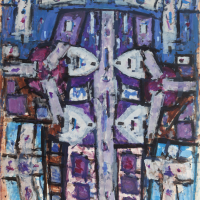47. ROGER KEMP

Roger Kemp is the Australian painter who most the embodies the philosophy, aims and values of Abstract art. Of the big names: Godfrey Miller (1893-1964), John Passmore (1914-2004), Tony Tuckson (1921-1973), John Coburn (1925-2006) and Robert Klippel (1920-2001), Kemp is the individual who more than most, remained fully committed to the loftier principles of Abstraction through changes in fashion, rejection, boom and bust. At the end of his long and illustrious career, his character and his work remain consistent. His paintings are intelligent, compassionate and spiritual.
The formal basis of Kemps work is remarkably concise, and yet is the foundation of a rich and resonant output. Circles and squares rendered in luminous blues, reds, greys and black tones, and disposed in bands of rhythmic patterns across relief-like shallow fields are the simple formal ingredients for Kemps whole lifes work. Occasionally, his paintings appear like organic clockwork, with machine-like elements recalling aspects of surrealism. The scale and character of his work is often close in character to stained glass.
Kemps best work has a triumphant epic quality, normally associated with grand history painting- it has much of the grandeur and weighty seriousness of the high Baroque and also displays a surging character comparable with classical music. The key to his work is its spirituality, and it is the elevated moral tone that is the most vital ingredient of his work, the aspect of his work that sets it apart.
Awards and art prizes were an important part of the Australian art world during the 1960s and 70s, and the Blake Prize for Religious Art was one of the better known competitions that drew interest from contemporary artists of the time. Not surprisingly, Kemp was twice the winner, in 1968 and 1970. While Kemps work is not necessarily non- denominational, the religious component is not forced and he is far from being a zealot. His organic/mechanistic paintings are more subtle and therefore more persuasive than some of the more obviously religious images that were submitted to the Prize committee during the Blake Prizes heyday.
Kemp has been seen as a counterpoint to his friend and contemporary: Fred Williams. These artists were the book-ends of Melbourne painting in the 1960s and 70s. Both emerged on the scene after lengthy apprenticeships around 1964, and together their parallel courses became fundamental in painting in Melbourne from that time onwards. Their work was influential to a generation of Australian artists, as much for the way they painted, as for their deportment as professional painters and mentors for art in Australia. Developments and innovations of each artists work was the subject of close scrutiny by fellow artists, curators and critics and both attracted the attention of the most serious collectors. The contribution made by both to Australian art came at a critical time and the paintings they produced are among the most important monuments of Australian art of the period.
Tim Abdallah BA